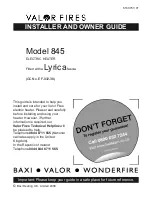
1. Mounting the Bracket
Locate a stud in the ceiling and attach the mounting bracket to the
ceiling joist as shown in figures 3-A or 3-B. You will need to
remove the mounting bracket from the heating unit by loosening
the bracket screws with a wrench and slipping the handle off over
the screw heads. Remember to place a washer on the screws
before you insert them through the holes in the mounting bracket
and screw them into the stud. Tighten the screws enough to
securely hold the heating unit with the air flow pointed in the prop-
er direction.
2. Hanging the Heater
Attach the heating unit to the mounting bracket. Lift the heater up
and into the mounting bracket. The bracket screws, located on
each side of the heating unit, allow the heater to be attached eas-
ily to the mounting bracket by aligning the screws with the keyhole
slots in the mounting brackets. If the heater is to be tilted, it must
be positioned in the lower keyhole slots (see Fig. 4). Tighten the
bracket screws with a wrench so the unit is securely suspended
at the desired horizontal or vertical angle.
3. Connecting the Power
To connect the power to the heater, simply remove the screw from
the front of the unit. This allows the hinged bottom to open, pro-
viding access to the electrical wiring and connectors. (See Fig. 4)
Attach the cable connectors to the unit (See Fig. 1, pg 2) and slide
the correctly sized wire through the cable connector. Pull enough
of the wire through the connector so you will have enough wire to
work with when you make the connections.
Connect the wire to the power terminal block located in the base
of the heater (See Fig. 5).
NOTE: TO DECREASE THE HEAT OUTPUT OF THE HEATING
UNIT, SEE TABLE 1 AND SCHEMATIC DIAGRAMS ON PAGE 4.
Turn on the power at the main service.
OPERATION
Setting the Thermostat
Rotate thermostat knob clockwise to high position. After room
reaches desired comfort level, rotate thermostat knob counter-
clockwise until the thermostat clicks off. (Note that the fan delay
will keep the fan running until the elements cool.) Heater will cycle
on and off to maintain room temperature.
NOTE: THE FIRST TIME YOU OPERATE THE UNIT, IT MAY
SMOKE SLIGHTLY. THIS IS DUE TO THE RESIDUAL CLEAN-
ING AGENTS USED TO CLEAN THE ELEMENT WHEN THE
HEATER IS MANUFACTURED. THIS IS NORMAL AND DOES
NOT INDICATE A PROBLEM WITH THE UNIT. THIS CONDI-
TION WILL STOP AFTER THE HEATER HAS BEEN IN OPER-
ATION FOR A FEW MINUTES.
Automatic Fan Delay:
The UH heater has an automatic fan
delay. When the thermostat calls for heat, fan action is delayed
momentarily until the heating elements warm. This prevents the
circulation of cold air. When the heater raises the temperature of
the room to the thermostat set point, the heating element is turned
off but the fan will continue to run until the heating element cools
down. This prevents exposing the unit to residual heat, provides a
higher comfort level and prolonged element life.
Thermal Cutout:
The UH heater is also equipped with a thermal
cutout which will automatically shut off the heater in the event of
overheating. The heater will turn on when the operating tempera-
ture returns to normal. Should the unit overheat and activate the
thermal cutout cycle, the cause of the overheating should be
determined before further operation.
NOTE:
If the unit is installed in an area where the temperature is
below 50° F, the fan may cycle on and off until the temperature in
the room rises above 50° F. This is normal and does not indicate
a problem with the unit. As soon as the heater warms the air in the
room above 50°, the unit will cycle normally.
3
Fig. 4
REMOVE SCREW TO OPEN DOOR
USE BOTTOM KEYHOLE
SLOTS IF HEATER IS
TO BE TILTED DOWN
rá
pp
y
M
ÎE
m
•»
En
ÎÓ
Ó»
N
ès
tâ
p
mw
lnv
w
V
w
W
mzââzx
étpè
Ézèpá
âpáxtylw
mwznv
Fig. 5
CEILING JOIST
WASHER
3
/
8
" DIAGONAL
LAG BOLT
BRACKET
CEILING JOIST
3/8" DIAGONAL
LAG BOLTS
BRACKET
WASHERS
Fig. 3-A
Fig. 3-B
3/8" DIAGONAL
LAG BOLT
Single-Screw Mounting
(Ill.1)
Double-Screw Mounting
(Ill.2)
























